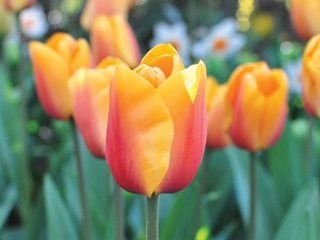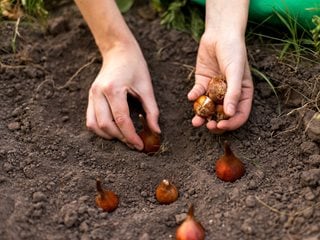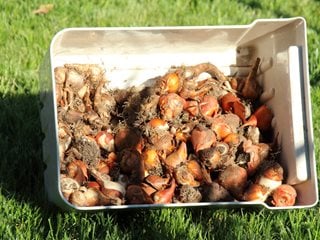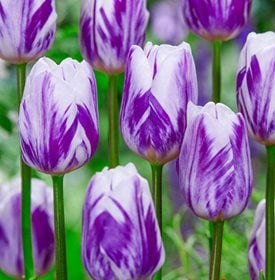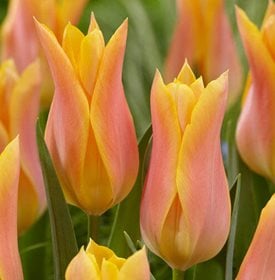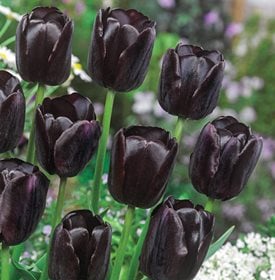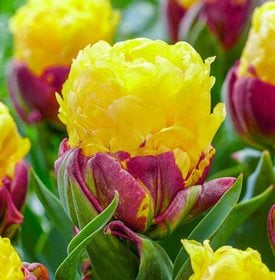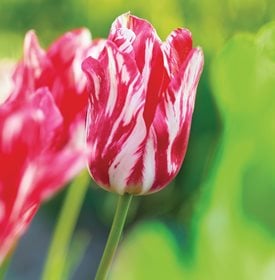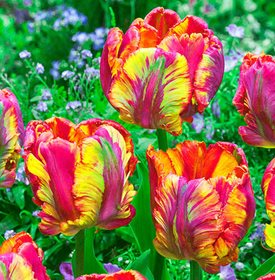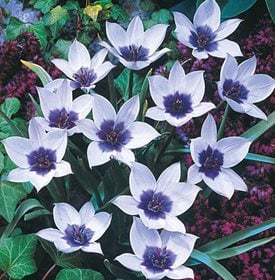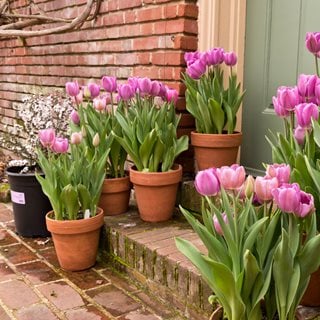Tulip Guide: How to Plant and Grow Tulips
Discover the do's and don’ts of planting tulip bulbs and get design ideas for incorporating tulip flowers into your garden.Iconic spring tulips are prized for their vast array of brightly colored flowers. Easily grown in borders or containers, many gardeners consider tulips a staple flower that they anxiously await each year.
On this page: Basics | Types | Planting | Care | Pictures | Garden Ideas | FAQ's
- TULIP BASICS
- TYPES OF TULIPS
- PLANTING TULIPS
- TULIP CARE
- TULIP VARIETIES
- USING TULIPS IN THE GARDEN
- TULIP FAQ'S
BASICS
Zones:
3 to 8. Tulips require 14 to 15 weeks of winter temperatures below 48 degrees to perform, faring best when springs are long and balmy with temperatures between 45 and 60 degrees.
Height:
Varieties from 6 to 24 inches tall.
When do tulips bloom?
From early spring to late spring, depending on the variety.
Exposure:
Full sun—in the shade, flower stalks can become weak and spindly and produce small flowers. Keep in mind that they grow and bloom before most deciduous trees leaf out.
Flower colors:
Large variety of single and multi-colored types. Popular colors include pink, white, red, orange, purple and yellow.
TYPES OF TULIPS
There are many varieties to choose from. Some have single flowers, others have double flowers, some have solid color foliage, others have variegated foliage, some bloom early, others bloom late—and the list goes on.
They can be classified into 15 cultivar groups, which are as follows:
- Species tulips (sometimes called wild or botanical tulips)
- Parrot tulips
- Fringed tulips
- Rembrandt tulips (the modern, virus-free version of broken tulips)
- Darwin hybrid tulips
- Triumph tulips
- Lily-flowered tulips
- Single early tulips
- Double early tulips
- Single late tulips
- Double late tulips
- Viridiflora tulips
- Kaufmanniana tulips
- Fosteriana tulips (also known as Emperor tulips)
- Greigii tulips
PLANTING TULIPS
When to plant tulip bulbs:
As a general rule, planting time is in the fall; more specifically:
- Zones 4 and 5: September to early October
- Zones 6 and 7: October to early November
- Zones 8 and 9: November to early December
- Zone 10: Late December to early January
Where to plant tulips:
Plant new bulbs in a location that will receive full sun, with good drainage. If planted in the shade, they’ll be weak and spindly with small flowers. If planting taller varieties, make sure they are in an area protected from strong wind.
How to plant tulips:
Bury the bulbs 6 to 8 inches deep, pointed end up, spaced 4 to 6 inches apart. To ensure that bulbs planted together will bloom at the same time, make sure they are planted at exactly the same depth.
Soil:
Because they are primed and ready when planted and then whisked away when they are done, soil isn’t a major issue. But given their druthers, tulips prefer a sandy loam soil and excellent drainage, and detest being sunk in soggy beds.
Learn more about how to plant bulbs.
TULIP CARE
Water:
Water when planted, but don’t water again until foliage appears. Bulbs don’t like wet feet.
Fertilizer:
Fertilize them in the fall when they are planted and establishing their roots and again when growth appears. Don’t fertilize after flowers have bloomed.
Pruning:
Deadhead flowers after the petals have dropped. After flowering, the plant will continue to grow and store nutrients for next year, so leave the foliage intact until it has completely died back.
Digging up tulips:
The best time to lift the bulbs is approximately six weeks after flowering, once the leaves have turned yellow. If necessary, use a garden fork to gently loosen the bulbs from the ground. If you want to lift earlier to avoid the unsightly foliage or make room for new plants, RHS recommends placing them in trays until the leaves become yellow and straw-like.
Storing tulip bulbs:
Gently remove any soil, old leaves, or roots from the bulbs. Separate any new bulbs that have formed. Make sure the bulbs are totally dry, or they will rot. Provide good air circulation, warm temperatures, and darkness until you are ready to replant. Many gardeners use trays or mesh bags for storage.
Pests & diseases:
Gray mold, slugs and snails, aphids, and bulb rot. Squirrels, rabbits, mice, and voles are frequent pests to bulbs, but can be deterred by placing holly or other thorny leaves in with the bulbs.
Additional care tips:
- Don't expect all tulips to come back—hybrids should be replanted annually.
- If refrigerator chilling prior to planting is necessary in your zone, don’t store bulbs in the same drawer with fruit as gases emitted from ripening fruit can cause bulbs to sprout.
- Store bulbs in a cool place in a paper bag (not plastic) before planting.
Learn more about how to dig & store bulbs.
TULIP VARIETIES
USING TULIPS IN THE GARDEN
Although an ocean of tulips is one way to go, there are many other creative ways to use them in your garden. Here are some ideas to try:
- Integrate with spring-blooming perennials in herbaceous borders.
- Tulips also play well with other bulbs, such as late-blooming daffodils, hyacinths and crocus.
- Blend varieties that bloom simultaneously, pairing complementary colors and harmonious shades for riveting displays (since it’s all in the timing, try a professionally crafted blend from www.colorblends.com).
- Conversely, plant tulips with different bloom times to extend your blooming season.
- Don't limit yourself to solid colors—try striped varieties or ones with subtle color-changing nuances.
FREQUENTLY ASKED QUESTIONS
Are tulips perennials?
Technically tulips are perennials and should be repeat bloomers, but they often fail to flower well beyond the first spring. Here is an excellent explanation of why your spectacular display declines to little or nothing. Many gardeners choose to replant fresh bulbs each year. If you are looking for tulips that will give you two or three years of flowers, consider species or naturalizing types.
Why didn’t my tulips come back?
The jumbo bulbs sold to gardeners are really the end of the line—grown with great skill under ideal conditions and to a size that is about as big as a tulip bulb can get. These large bulbs split into several smaller bulbs, so their second-season flower show is inevitably reduced.
Here are some more reasons why tulips stop blooming:
- You live in a climate where the temperature doesn’t fall below freezing. Grow them as annuals instead.
- The bulbs rotted due to too much moisture in the soil. Pick a well-drained location or dig up the bulbs and store them.
- They didn’t get enough sun. Plant in a full sun location.
- You removed last year’s foliage before the bulb stored enough energy. Wait until all the leaves have died.
- Your soil is lacking key nutrients. Fertilize in fall and spring with a low-nitrogen fertilizer.
Should I plant tulip bulbs or seeds?
Make sure you are buying bulbs, not seeds. Tulip seeds can be tough to start and will take a few years to produce flowers.
Are tulips poisonous?
Tulips are known to be toxic to humans when ingested, and the ASPCA lists them as being toxic to dogs, cats, and horses. Then main concentration of toxin is in the bulb, however, all parts of the plant except the petals are poisonous. See Common Poisonous Plants for Dogs and Cats.
Are tulips deer resistant?
Unfortunately, tulips are not deer resistant. Some tips to help yours avoid being eaten by deer are to position them amidst strongly-scented or prickly plants, near something that makes motion or noise, placing other strong-smelling items near them (mothballs, garlic, onions, etc.), or setting sprinklers to go on near dawn and dusk times (breakfast and dinner time for deer).
This article was adapted from its original version for use on the web.
RELATED:
How & When to Plant Bulbs
Annuals for Sun
Top 20 Spring-Blooming Bulbs
